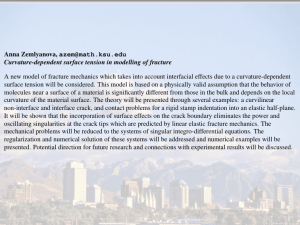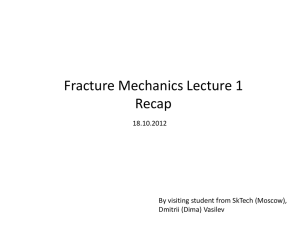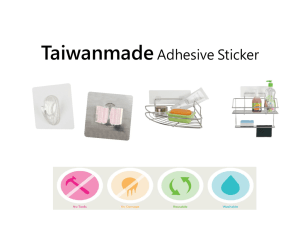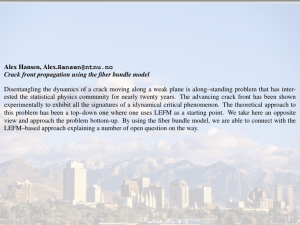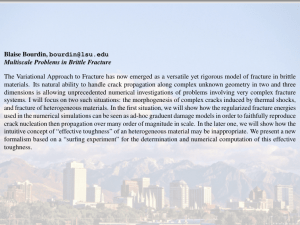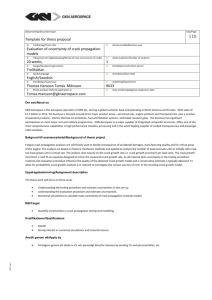Use of the Double Torsion ... Propagation in an Adhesive Layer
advertisement
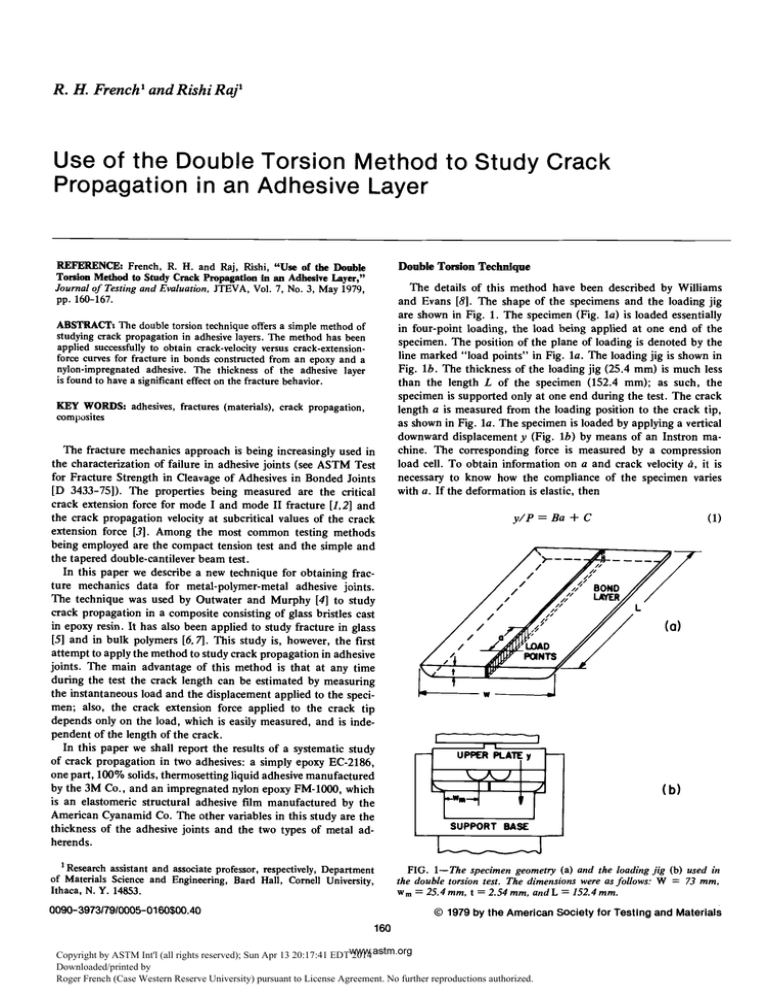
R. H. French i and Rishi RajI
Use of the Double Torsion Method to Study Crack
Propagation in an Adhesive Layer
REFERENCE: French, R. H. and Raj, Rishi, "Use of the Double
Torsion Method to Study Crack Propagation in an Adhesive Layer,"
Journal o f Testing and Evaluation, JTEVA, Vol. 7, No. 3, May 1979,
pp. 160-167.
Double Torsion Tedmlque
ABSTRACT: The double torsion technique offers a simple method of
studying crack propagation in adhesive layers. The method has been
applied successfully to obtain crack-velocity versus crack-extensionforce curves for fracture in bonds constructed from an epoxy and a
nylon-impregnated adhesive. The thickness of the adhesive layer
is found to have a significant effect on the fracture behavior.
KEY WORDS: adhesives, fractures (materials), crack propagation,
composites
The fracture mechanics approach is being increasingly used in
the characterization of failure in adhesive joints (see ASTM Test
for Fracture Strength in Cleavage of Adhesives in Bonded Joints
[D 3433-75]). The properties being measured are the critical
crack extension force for mode I and mode II fracture [1,2] and
the crack propagation velocity at subcritical values of the crack
extension force [3]. Among the most common testing methods
being employed are the compact tension test and the simple and
the tapered double-cantilever beam test.
In this paper we describe a new technique for obtaining fracture mechanics data for metal-polymer-metal adhesive joints.
The technique was used by Outwater and Murphy [4] to study
crack propagation in a composite consisting of glass bristles cast
in epoxy resin. It has also been applied to study fracture in glass
[5] and in bulk polymers [6, 7]. This study is, however, the first
attempt to apply the method to study crack propagation in adhesive
joints. The main advantage of this method is that at any time
during the test the crack length can be estimated by measuring
the instantaneous load and the displacement applied to the specimen; also, the crack extension force applied to the crack tip
depends only on the load, which is easily measured, and is independent of the length of the crack.
In this paper we shall report the results of a systematic study
of crack propagation in two adhesives: a simply epoxy EC-2186,
one part, 100% solids, thermosetting liquid adhesive manufactured
by the 3M Co., and an impregnated nylon epoxy FM-1000, which
is an elastomeric structural adhesive film manufactured by the
American Cyanamid Co. The other variables in this study are the
thickness of the adhesive joints and the two types of metal adherends.
] Research assistant and associate professor, respectively, Department
of Materials Science and Engineering, Bard Hall, Cornell University,
Ithaca, N. Y. 14853.
0090-3973/79/0005-0160500.40
The details of this method have been described by Williams
and Evans [8]. The shape of the specimens and the loading jig
are shown in Fig. 1. The specimen (Fig. la) is loaded essentially
in four-point loading, the load being applied at one end of the
specimen. The position of the plane of loading is denoted by the
line marked "load points" in Fig. la. The loading jig is shown in
Fig. lb. The thickness of the loading jig (25.4 mm) is much less
than the length L of the specimen (152.4 mm); as such, the
specimen is supported only at one end during the test. The crack
length a is measured from the loading position to the crack tip,
as shown in Fig. la. The specimen is loaded by applying a vertical
downward displacement y (Fig. lb) by means of an Instron machine. The corresponding force is measured by a compression
load cell. To obtain information on a and crack velocity ~, it is
necessary to know how the compliance of the specimen varies
with a. If the deformation is elastic, then
y/P=
(1)
Ba + C
//
/
II
[
/ / , / ,"
/
//BO.O / / /
/ - 1,;"
"
/,#
W-
.,_w,,,_..~11
//." /
//
/
,
J
--3
~
~I ~_
(b)
SUPPORT BASLE
FIG. 1--The specimen geometry (a) and the loading jig (b) used in
the double torsion test. The dimensions were as follows: W = 73 m m ,
Wm = 2 5 . 4 m m , t = 2 . 5 4 m m , a n d L = 1 5 2 . 4 m m .
© 1979 by the American Society for Testing and Materials
160
Copyright by ASTM Int'l (all rights reserved); Sun Apr 13 20:17:41 EDT 2014
Downloaded/printed by
Roger French (Case Western Reserve University) pursuant to License Agreement. No further reproductions authorized.
161
FRENCH AND RAJ ON CRACK PROPAGATION
where P is the load and B and C are constants, C being the
compliance of the specimen when a = 0. For sufficiently long
cracks, Ba >> C, an approximate formula can be derived for
B [81:
B = 3win21 Wt3G
(2)
where G is the shear modulus of the adherends and Win, B e, and
t are as shown in Fig. 1. It is possible, of course, to measure the
actual value for B and to compare it with the value calculated
from Eq 2. As we shall report later, we find that they agree to
within 10% error. This justifies the assumption that local crack
tip plasticity does not significantly affect the compliance, particularly in our test since all the plasticity is confined to the
adhesive layer, which is much thinner than the width of the
specimen.
Differentiating and rearranging terms in Eq 1 leads to an
expression for the crack velocity in a constant displacement test
(p = 0):
a = --(Py/p2B)
(3)
The relationship between a, P, and the stress intensity factor
K can be obtained semiempirically. There are some unanswered
questions as to the mode of fracture in this type of test, although
it has been shown that the crack moves approximately perpendicular to its front and that the fracture is primarily mode I [8].
This is particularly true when the crack is moving in the midsection of the specimen. An exact analysis for K I for this geometry
has not been carded out but the following approximate formula
has been shown to provide a valid value for K i in many systems [8]:
KI = A P
A =wm
.3 (1 + v) )1/2
Wt 4
Specimen Preparation
The specimens were prepared from two types of alloys, 2024
aluminum alloy and stainless steel, and from two types of adhesives,
EC-2186 and FM-1000. The thickness of the adhesive joints in
the specimens was controlled by inserting shims at the ends of
the specimens. The adhesive joints ranged from 25 to 250 #m
in thickness, which was measured optically at four locations along
the glue line. It did not vary by more than 10°7o.
The surfaces to be glued were ground flat to a textured finish.
The plates were then cleaned with a commercial detergent, degreased in carbon tetrachloride solution for 10 min at 50°C, and
etched. 2 They were then rinsed in water and methanol and blowdried. Both adhesives were cured at 182 ___ 10°C for 1 h and
then cooled to room temperature. The samples were brought up
to the cure temperature in less than 45 min. During the curing
process a constant pressure of 172 kPa (25 psi) was applied by
means of a spring-loaded alignment jig. After preparation, the
specimens were stored in a vacuum of 1.33 Pa (0.01 torr).
The aluminum specimens, in most cases, fractured cohesively
with the crack propagating near the center of the adhesive layer.
The few cases when it did not were not included in the test results
reported here. Considerable difficulty, however, was experienced
with the preparation of the stainless steel specimens. The fracture
always propagated very near one of the interfaces even though
it occurred within the adhesive. The results from these tests are
therefore considered to be anomalous; they are described briefly
in the Appendix, and Figs. 2 and 3 show the fracture surfaces
of the aluminum and stainless steel specimens.
Determination o f the Constant B in Eq 1
(4)
where v is the Poisson's ratio. Note that g l depends only on P and
the specimen geometry; it is independent of a.
In the study of adhesives it is more appropriate to describe the
crack propagation behavior in terms of the crack extension force
~i since g l is independent of the elastic constants of the adherend
while KI is not. For crack propagation in mode I, plane strain,
they are related as follows [9,10]:
g[ = (1 -- u2)KI2/E
Experiments
(5)
where E is Young's modulus.
For sufficiently thin layers of the adhesive, g l will be nearly
independent of the elastic properties of the adhesive because it is
a measure of the change in the potential and elastic energy when
the crack propagates. Since only a small fraction of the total elastic
energy is stored in the adhesive layer, the influence of the elastic
properties of the adhesive on g l will be small.
The actual tests were performed by applying a displacement to
the specimen as rapidly as possible and then holding that displacement fLxed. As the crack propagates, the compliance increases and the load decreases. The values of a, t~, and g l at
any instant during the test may be calculated by means of Eqs
1 , 3 , 4 , and5.
We prepared six specimens which did not contain a bonded
layer but which had had cracks of different lengths machined
into them. The compliance of these specimens was measured and
plotted against a, as shown in Fig. 4. The measured value of B
compared favorably with the value calculated from Eq 2, as is
also shown in Fig. 4. The measured values for B were 5.45 )<
10 -4 kg -1 for the aluminum specimens. The values used for
the elastic constants for aluminum were E = 71.8 GPa, v ---0.33, and G = 26.2 GPa [11].
Testing
The tests were carded out within an environmental chamber
maintained at a constant temperature of 308 K and 9°70 humidity.
The specimens were subjected to cyclic loading to sharpen the
crack and propagate it a short distance forward. The sample was
then loaded rapidly to a load of 294 to 588 N (30 to 60 kgf) at
a rate of 0.3 mm/s and then the displacement was held constant
and a load relaxation curve was obtained. The procedure was
repeated until the crack had propagated through the entire length
of the specimen.
The data analysis consisted of recording the net crosshead
displacement and measuring the slope of the load-time curve and
2The etchant for aluminum was 30 parts distilled water, 10 parts
sulfuric acid, and 1 part sodium dichromate. Plates were etched for 10
min at 70°C with agitation. The etchant used for stainless steel was 3
parts hydrochloric acid and 1 part nitric acid for 10 rain with agitation.
Copyright by ASTM Int'l (all rights reserved); Sun Apr 13 20:17:41 EDT 2014
Downloaded/printed by
Roger French (Case Western Reserve University) pursuant to License Agreement. No further reproductions authorized.
162
JOURNAL OF TESTING AND EVALUATION
iO- j _
3
4
I
I
o
~(~m)
50
50
50
•
•
•
•
109
IO9
IO9
109
K.r (M Po ~/~)
5
6 7 e
1
i
I
I
ii
I
oi(cm)
8.3
I1.1
12.8
7.3
8.0
8.5
I0.O
I
I
15 17 20
I
I
I
I
I
SS-FMIOOO
15 z
E
"O
i0-~
4
i(~4
#
!
,
,
, , , , , I
0.1
,
=
J
a
L , i,,,I
4 s 6 7a91. 0
H ~ I (kN m-I)
FIG. 3--A comparison of the fracture surfaces for aluminum and
stainless steel specimens. In stainless steel specimens fracture occurred
very close to the metal-adhesive interface. The thickness of the adhesive
in both cases was approximately 50 #m.
FIG. 2--The effect of adhesive layer thickness on fracture for stainless steel specimens bonded by FM-I O00 adhesive.
the instantaneous load at several points along the relaxation
curve. Also, the initial and the final crack lengths at the start
and the end of each relaxation were calculated as a check on
the velocity values calculated from Eq 3.
To minimize the error resulting from machine relaxation the
specimens were preloaded to a small load (98 to 196 N [10 to 20
kgf]) for 3 min. In spite of this procedure, it remained likely
that some error was still occurring. To estimate this error, relaxation curves for the machine were obtained at loads and time
intervals comparable to tests carded out with the specimens.
These relaxations were subtracted from the relaxation~ from the
specimens and the a(gl) curves obtained from corrected relaxation were compared with those from the original relaxation. The
correction was less than the scatter in the experimental data.
Z
/7
'2
ALUMINUM
E
%
EQ. (2)
>.la-
/
//
W
0
Z
Q.
M e a s u r e m e n t o f the A m o u n t o f Crack Propagation During Each
Relaxation
To ascertain whether or not the crack velocities were being
measured accurately during the load relaxation experiment the
following test was carded out: the increase in the length of the
crack during a load relaxation was estimated by the measurement
of the compliance of the specimen at the start and at the end of
the load relaxation; it was then compared to the increase in crack
length computed independently from the integration of the velocity
versus time curve obtained from the relaxation. The velocity was
o
o
0
I
O
2.54
I
5.08
I
7.62
I
10A6
I
1270
a (cm)
FIG. 4--Measured and calculated values for the constant B in Eq 1
for aluminum.
Copyright by ASTM Int'l (all rights reserved); Sun Apr 13 20:17:41 EDT 2014
Downloaded/printed by
Roger French (Case Western Reserve University) pursuant to License Agreement. No further reproductions authorized.
FRENCH
AND
RAJ O N C R A C K
163
PROPAGATION
calculated from the instantaneous values of P and P at various
time intervals by use of Eq 3. A typical velocity-time curve is
shown in Fig. 5. The total crack advance is equal to the area
beneath the curve. In this example it is equal to an increase in
crack length of 8.5 mm. The value calculated from the change in
compliance was 11 mm. In another test the values were 6.7 and
8.0 mm, respectively. It is reasonable that the compliance value
is larger than the value obtained from the velocity-time integral
since the latter does not include the crack growth at times longer
than 12 s (a typical relaxation test lasted for 3 rain). Bearing
this in mind, we can consider the agreement to be good.
K z (M Po ¢'~)
3
I
'm
E
a<
,a
,,
;
9
TIME
I0
II
12
(sec)
FIG. S--Change o f crack velocity with time as obtained from a load
relaxation curve. The net increase in the length o f the crack (equal to
the area under the curve) was 8.5 ram.
5
6
I
I
I
a
(/zrn)
15'
7 8
I
[
II
I
I
I
15 17 20
I
I I I
I
Gi
(cm)
o
Results
In this section the t~(gl) curves for crack propagation in EC2186 and FM-1000 are presented. The primary structural parameter in these tests was the thickness of the adhesive layer. The
results for aluminum specimens are summarized in Figs. 6 and 7
(those for stainless steel specimens are described in the Appendix).
A typical load relaxation curve for which the d(~i) curves were
obtained is shown in Fig. 8. The slopes of the crack propagation
curves were very large, and the stress intensity exponent n in
the relationship ,i = / ~ i " , where/~ is a material parameter, was
in the range of 10 to 50. The slope and the shape of the curves
are in agreement with the measurements of Beaumont and Young
[6] and Hodkinson and Nadeau [7] on bulk polymeric materials.
The main difference between fracture in adhesive joints and
fracture in bulk polymers is that in the former the deformation
of the polymer is confined to a narrow layer. If the plastic zone
size in the polymer at the crack tip is larger than the thickness
of the adhesive layer, then fracture would become sensitive to
this thickness. The results presented below show that the crack
propagation behavior is indeed sensitive to the thickness of the
adhesive layer.
Since the slope of the a(g i) curves is large, we shall characterize
the fracture behavior by specifying the range of the crack extension
force g mi, to g m~, in which crack propagation was observed.
The crack propagation velocity was measured in the range 10-s
t o 10 -~ m/s.
4
25
•
42
•
42
A 240
n 240
<> 2 4 0
AI - FMIO00
14.5
84
I0. I
9.0
9.7
10.8
02
I
o,
/
E
I
10-5
, i ,tl
0.I
J
I
I I
a ill
2
s
4
7 e el. 0
~I
n
y/
I
I
I
(kN m-I)
FIG. 6--The effect o f adhesive layer thiekness a on fraeture for
aluminum specimens bonded by FM- I O00 adhesive.
E f f e c t o f B o n d Thickness
In all cases the fracture resistance was sensitive to the thickness
of the adhesive layer. For example, as shown in Fig. 7 for the
FM-1000 adhesive, the range of ~I values in which fracture was
observed was 0.61 to 0.68 kN/m for a 25-#m-thick adhesive
layer, 0.70 to 0.96 kN/m for a thickness of 42 #m, and 1.17 to
3.02 kN/m for a thickness of 240 #m. In the case of the 240-ttmthick adhesive, the fracture behavior was also sensitive to the
length of the crack. For example, as a increased from 90 to 108
mm, the g i for propagation increased by a factor of nearly 2.5.
The sensitivity to a may be attributed in part to the fact that the
shape of the crack front changes with crack length, as shown
in Fig. 9. However, since this effect was observed only for thick
bonds on the order of 240 gm, plasticity in the adhesive layer
may be an explanation. In the double torsion technique, the
applied displacement is accommodated by elastic deformation of
the metal plates and by plastic bending in the adhesive. For
accurate ~I measurements most of the deformation should be
stored in the plates. As the adhesive layer becomes thicker, however, the plastic bending component increases, which increases
the error in estimating ~l. As shown in Fig. 9, the crack shape
occupies a larger area in the adhesive as it grows longer; therefore,
if plasticity in the adhesive is important, the apparent g[ will
increase as a increases.
Copyright by ASTM Int'l (all rights reserved); Sun Apr 13 20:17:41 EDT 2014
Downloaded/printed by
Roger French (Case Western Reserve University) pursuant to License Agreement. No further reproductions authorized.
164
JOURNAL OF TESTING AND EVALUATION
K z (M Po ~r~)
3
i
~(/.zm)
o
50
0
50
lo-'
&
o
•
•
•
4
i
ai(cm)
5.6
6.0
50
50
28
50
50
5
i
8.7
I0.7
9.6
6.9
9.2
6
i
7
i
8
i
/
AI - - E C 2 1 8 6
i
i
II
i
15 17 2 0
i i i i
i
o
AI - - F M I 0 0 0
e/ ( ~ = 42~m)
tA
15 2
I
I
•
."
E
"O
id s
FIG. 9 - - T h e crack f r o n t changes with the length o f the crack in the
double torsion experiment. The pictures o f the front were obtained by
propagating the crack to some distance and then spraying it with a die
penetrant. The dark areas are the fractured parts o f the adhesive layer.
o'I
I
~
[
la¢
i
I
I
I
I
• "
from such defects as air bubbles. The EC-2186, on the other
hand, is a paste, and it is likely that air bubbles get trapped in
the adhesive layer during fabrication. Such defects can be expected
to lower the fracture strength of the adhesive layer [12].
,G 4
I
O l
Discussion
4~A A
I
I
id 5
I
0.1
{
The double torsion technique has been used to study crack
propagation in adhesive joints. The equation normally used to
describe d(~i) behavior is
I
~'~I(kN m-t)
=/~g,"
FIG. 7--A comparison o f the fracture properties o f two types o f
adhesives f o r aluminum specimens.
AI - F M I 0 0 0
a i = 8.4crn
40
3
0
CROSSHEAD DISPLACEMENT =
0 . 6 4 mm
~
Q.
20
I0
'
zb
,
40
,
.
,
60
TIME
,
. ,
80
I00
,
120
140
(sec)
FIG. 8--A typical load relaxation curve f o r a constant displacement test.
Results for Two Different Adhesives
A comparison of the results for fracture in the adhesive layer
between aluminum plates for the adhesive EC-2186 and FM-1000
are shown in Fig. 7. The EC-2186 is a lower toughness material
than the FM-1000. Furthermore, the spread in the data was
greater for EC-2186 than for FM-1000. This spread, we believe,
represents the variability in the bond during fabrication. The
FM-1000 is a film-type adhesive; therefore, provided the surfaces
are well prepared, it is possible to prepare a bond that is free
(6)
where/3 and n are material parameters, and n is normally temperature-independent. In our experiments we have found that n
changes from a range of 10 to 15 for crack velocities less than
10-4 m/s to a range of 35 to 50 for crack velocities higher than
about 10-3 m/s. These values for n are in agreement with the
measurements of crack growth in bulk polymers reported in the
literature [6, 7]. We did not observe the three distinct stages of
crack growth normally associated with time-dependent crack
propagation, which is also in agreement with these measurements.
The evidence, then, is that only stage III crack growth is observed
in polymers, that is, time-dependent crack growth is observed
only at g[ values slightly less than gic, and that the crack velocity
varies very rapidly with g [.
We now compare our measurements of g[ for crack propagation in adhesive joints with other measurements in adhesive joints
and bulk polymeric materials. For the aluminum specimens the
~Ic values (defined as the crack extension force required to propagate the crack at a rate of 0.1 m/s) were 0.90 kN/m for 42-#mthick adhesive joints and 3.02 kN/m for 240-pm-thick adhesive
joints, for the FM-1000 adhesive; the value for the EC-2186
adhesive was 0.57 kN/m for a joint thickness of 50 #m. In an
earlier study [13] the g ] for fracture in these adhesives was measured by using compact tension specimens. The specimens were
machined in two halves from aluminum to standard specifications for external dimensions [14]. The two halves were bonded
by placing the adhesive between the two halves, holding with
a C clamp, and curing at 180°C for 1.5 h. The specimens were
tested in an Instron machine at a displacement rate of 0.0.5 to 1.3
mm/min. The average g l measured for EC-2186 was 0.82 kN/m
Copyright by ASTM Int'l (all rights reserved); Sun Apr 13 20:17:41 EDT 2014
Downloaded/printed by
Roger French (Case Western Reserve University) pursuant to License Agreement. No further reproductions authorized.
FRENCH
A N D RAJ ON C R A C K
165
PROPAGATION
a n d for FM-1000 was 3.71 kN/m. Unfortunately, the thickness of
the joints was not carefully controlled in these experiments [13],
and therefore these results are not directly comparable with the
measurements reported in this paper. Nevertheless, these values
are within 20% of the 9] values measured by us. Given the variability in the fabrication procedure, the agreement is fairly good.
Mostovoy et ai [15,16] have performed tapered double-cantilever
beam experiments on DER-332 resin using curing, bond thickness,
and hardener as variables. Their results indicated critical g l
levels from 0.06 to 0.24 kN/m. These are about half as large
as the ~1 values measured by us for EC-2186. Beaumont and
Young [6] have reported ~1 levels of 0.04 to 0.06 kN/m for
fracture in bulk silica-filled epoxy. The conclusion to be drawn
is that from a fracture toughness point of view these materials
are inferior to EC-2186 and FM-1000.
Our measurements indicate that g l for crack propagation is
sensitive to the bond thickness. Since in the aluminum samples
fracture occurred cohesively and near the center of the adhesive
layer, the preparation of the bond should not have been a factor
in these results. One approach to explain these results is to
consider the joint as a composite material where the thickness
of the adhesive layer is thin as compared to the metal and where
the elastic modulus of the adhesive is lower than that of the
metal. The sensitivity of g i to the thickness of the adhesive layer
/~ and to E / E ' (where E and E ' are the Young's moduli for
the metal and the polymer, respectively) can then be calculated
if all deformation is assumed to be elastic. In elastic deformation
the stress singularity at the crack tip is maintained and g l is a
true crack extension force. Two procedures have been used to
calculate g l for crack propagation in the adhesive. In one, a
crack contained in a slender strip that represents the adhesive
layer is considered [17-19]. The stress analysis is carded out for
different sets of boundary conditions at the strip boundaries.
These calculations are necessarily approximate since the boundary
conditions should be determined by the tractions and displacements at the metal-adhesive interface that occur as a result of
the deformation of the composite as a whole rather than by the
deformation of the adhesive layer by itself. It is preferable to
consider the coupling of the deformation in the metal and the
adhesive. This has been carded out recently by Wang et al [20].
They have analyzed the double-cantilever beam configuration of
the specimen, but results pertaining to the effect of /~ on g l
should have general applicability. A plot of_~l normalized with
respect to the value for the monolithic case g i, as a function of
iS, was obtained from the calculations of Wang et al [20] by using
the following procedure. For the monolithic case KI 2 = (12 P a /
hb3)/(1 _ v2), where P is the load applied to the double-cantilever
beam specimen, a is the crack length, b is the thickness of the
beam in the plane of the crack, and h is the height of the beam
normal to the plane of the crack [21]. Substituting KI into Eq S
yields the expression for g i. The actual g l as calculated by Wang
et al for the case of the composite was related to an apparent
KI app according to the equation 3 ~I : (Klapp)2/E ', which
leads to the equation:
.
~I
gl
.
.
1
12
(KI app)2
.
.
E
Pa/hb 3
(7)
E'
The right-hand side of Eq 7 has been calculated in Ref 20 as a
function of t~. The results in terms of g are given in Fig. 10. The
influence of the thickness of the adhesive layer on g l is small.
The relative elastic modulus of the adherend and the adhesive
has a much stronger influence, but the effect is nonlinear: at
small ratios of E / E ' the effect is stronger than for larger values
E / E ' . The influence of t~ as measured by us (Fig. 7) is much
stronger than the curves in Fig. 10 and hence cannot be explained
by considerations of linear elastic fracture mechanics.
It has been shown, however, that concepts from linear elastic
fracture mechanics can he applied even when the crack tip is
blunted by local yielding and the stress singularity is no longer
present. A simple model to consider is the rigid-plastic strip
model [9] that has been analyzed by Rice [22]. The thin strip is
assumed to be rigid below a critical stress ay, above which it
yields without strain hardening. Yielding occurs locally near the
crack tip. One measure of the extent of yielding is the crack tip
opening displacement ~b, which is given by [22]
~b = g]/(1 -- ~2)t~y
(8)
DCB SPECIMEN
E/E ~
2O
"1" 1.8
I---I
o
z
o 1.6
~E
o
v
0
D
1.4
H
I'00
200
I000
a
n
25 0
125
I
575
I
500
625
8 (p.m)
FIG. lO--The influence of the adhesive layer thickness and the relative Young's modulus of the metal and the adhesive on ~1 ( Eq 7).
METAL
. ~ ~ ~ , ~ F I B
~
i
~
l
RILS
RUPTURED
[~"FIBRIL S
(o)
A thick odhesive Ioyer
CRAZE
ADHESIVE
(b)
A thin odhesive foyer
3In Ref 20 the results are expressed in terms of KI (apparent) rather
than gl. The two are related by Eq 5. An ambiguity arises in the value
of K! depending on whether the elastic constants for the adhesive material
or for the metal are inserted into Eq 5. But g] is an unambigously
defined quantity and hence is used here to avoid misinterpretation of
results.
FIG. 11--A speculative model of crack propagation in an adhesive
layer bonded between two metal plates.
Copyright by ASTM Int'l (all rights reserved); Sun Apr 13 20:17:41 EDT 2014
Downloaded/printed by
Roger French (Case Western Reserve University) pursuant to License Agreement. No further reproductions authorized.
166
JOURNAL OF TESTING AND EVALUATION
for plane strain loading. Note that here g i is not a true extension
force but an apparent quantity calculated with the assumption of
elastic deformation. Equation 8 by itself does not invoke a crack
propagation criterion since the crack is not supposed to have
moved in its calculation. However, if some microstructure-dependent criterion is invoked, such as that the crack propagates
when a critical amount of strain ~c is accumulated in the adhesive
layer in the immediate vicinity of the crack tip, then Eq 8 may
be used to define an apparent critical value for g l. We would
then use the following fracture criterion:
~ >---Ec
where
ec = dpc/~ = 91/(1 -- V2)ay~
(9)
Qualitatively this criterion would explain why 9I increases with
6, but it must be noted that the derivation of Eqs 8 and 9 was
based on the assumption that the adhesive yields uniformly across
the entire thickness. This is clearly an approximation since preferential yielding near the crack tip should lead to a nonuniform
distribution of strain in the thickness direction in the adhesive.
Polymers are known to craze before they fracture. The micromechanics of the formation of the craze and then the propagation
of a crack into a craze is complex. The criteria for air-crazing
have been reviewed extensively [23-25], and the breaking of craze
fibrils to advance a crack has also been studied [26-27]. A discussion of these topics in the context of crack propagation in a
polymer in the form of an adhesive in a composite material is
outside the scope of this paper. But some qualitative ideas that
may explain the influence of 6 on gl are illustrated in Fig. 11.
When /~ is large, several crazes may form before one of them
fractures. As a result, a large displacement at crack tip opening
displacement will be required to attain fracture (Fig. lla). On
the other hand, if/~ is small, fewer crazes may form and smaller
crack opening displacement may be required (Fig. l l b ) . Clearly
the micromechanics of craze deformation must be studied independently before such models can be applied. A current review
of such studies is available [28].
Summary
The double torsion technique offers a simple method of studying crack propagation in adhesive layers. The technique has
been used successfully to obtain curves for crack velocity versus
crack extension force. The critical g l levels measured by this
method for two adhesives EC-2186 and FM-1000 are in good
agreement with the values obtained from compact tension specimens. The fracture toughness of the nylon-impregnated FM-1000
adhesive was more than 1.5 times the toughness of the simply
epoxy EC-2186 adhesive.
We have also considered the effect of the joint thickness on
g l for crack propagation. As joint thickness increases, ~l increases. These results imply that the microscopic process of
fracture at the crack tip in the adhesive layer needs to be studied.
The indication is that the adhesive does not fracture in brittle
manner; instead, it yields at the crack tip. It is suggested that
crazes form in the adhesive layer near the crack tip and that
the breaking of the fibrils in the craze leads to crack propagation.
Acknowledgment
This work was supported by the National Science Foundation
through the Materials Science Center at Cornell University.
APPENDIX
Test Results for Stainless Steel Specimens
The purpose of these experiments was to determine whether or
not crack propagation in adhesive layers is not g i controlled. Strictly
speaking, g l is a true crack extension force only if the stress
singularity at the crack tip is not removed by yielding. But Eq 9
indicates that, even if the polymer yields, a quantity such as a
critical amount of strain in the adhesive layer near the crack
tip may be used as a failure criterion, which is still related to
g l. Since g i is independent of the elastic constants of the adherend
metal, the study of fracture using adherend metal of different
elastic constants (for example, aluminum and stainless steel)
should yield the same value for g l for fracture. As shown in
Fig. 2 the critical g i values for stainless steel specimens were
consistently less than those for the aluminum samples, the thickness of the adhesive layer remaining constant (compare Fig. 2
with Fig. 5). Unfortunately, these results more clearly reflect a
difference in the quality of the bond in aluminum and stainless
steel samples rather than a change in the intrinsic mechanism of
fracture in the adhesive layer. The fracture surfaces from the
two types of specimens are shown in Fig. 3. Although in both
cases fracture is cohesive, in stainless steel specimens fracture
occurs very close to one of the metal-adhesive interfaces. These
results, therefore, only serve to show that 91 for fracture is fairly
sensitive to the quality of the bond.
The following values for the elastic constants for stainless steel
were used: E = 200.1 GPa, G : 73.1 GPa, and v = 0.30 [11].
References
[1] Ripling, E. J., Mostovoy, S., and Corten, H. T., "Fracture Mechanics: A Tool for Evaluating Structural Adhesives," Journal of
Adhesion, Vol. 3, 1973, pp. 107-123.
[2] Ripling, E. J., Mostovoy, S., and Patrick, R. L., "Measuring
Fracture Toughness of Adhesive Joints," Materials Research and
Standards, Vol. 4, No. 3, March 1964, pp. 129-134.
[3] Gledhill, R. A. and Kinloch, A. J., "Crack Growth in Epoxy Resin
Adhesives," Journal of Materials Science, Vol. 10, 1975, pp. 12611263.
[4] Outwater, J. O. and Murphy, M. C., "The Influences of Environment and Glass Finishes on the Fracture Energy of Glass-Epoxy
Joints," Journal of Adhesion, Vol. 2, Oct. 1970, pp. 242-253.
[5] Kies, J. A. and Clark, B. J., Fracture--1969, P. L. Pratt, Ed.,
Chapman and Hall, Ltd., London, 1969, pp. 483-491.
[6] Beaumont, P. W. and Young, R. J., "Failure of Brittle Polymers by
Slow Crack Growth," Journal of Materials Science, Vol. 10, 1975,
pp. 1334-1342.
[7] Hodkinson, P. H. and Nadeau, J. S., "Slow Crack Growth in
Graphite," Journal of Materials Science, VoL 10, 1975, pp. 846856.
[8] Williams, D. P. and Evans, A. G., "A Simple Method for Studying
Slow Crack Growth," Journal of Testing and Evaluation, Vol. 1,
No. 4, July 1973, pp. 264-270.
[9] Corten, H. T., "Fracture Mechanics of Composites," in Fracture,
H. Liebowitz, Ed., Academic Press, New York, 1972, p. 675.
[10] Irwin, G. R., Handbuch der Physik, Vol. 6, S. Fliigge, Ed.,
Springer-Verlag, p. 551.
Copyright by ASTM Int'l (all rights reserved); Sun Apr 13 20:17:41 EDT 2014
Downloaded/printed by
Roger French (Case Western Reserve University) pursuant to License Agreement. No further reproductions authorized.
167
FRENCH AND RAJ ON CRACK PROPAGATION
[11] McClintock, F. A. and Argon, A. S., Mechanical Behavior of
Materials, Addison Wesley, Reading, Mass., 1966, p. 86.
[12] Raj, R. and Dang, C. H., "De-Adhesion by the Growth of PennyShaped Bubbles in an Adhesive Layer," Philosophical Magazine,
Vol. 32, 1975, pp. 909-921.
[13] Fischer, F. L., "Crack Propagation in an Adhesive Layer," M.S.
thesis, Department of Mechanical Engineering, University of Colorado, Boulder, 1975.
[14] Brown, W. F. and Srawley, J. E., Plane Strain Crack Toughness
Testing of High Strength Metallic Materials, STP 410, American
Society for Testing and Materials, Philadelphia, 1966, p. 129.
[15] Mostovoy, S., Ripling, E. J., and Bersch, C. F., "Fracture Toughness of Adhesive Joints," Journal of Adhesion, Vol. 3, 1971, pp.
125-144.
[16] Mostovoy, S. and Ripling, E. J., Journal of Applied Polymer Science,
Vol. 1S, 1971, p. 661.
[I 7] Paris, P. C. and Sih, G. C., "Stress Analysis of Cracks," in Fracture Toughness and Its Applications, STP 381, American Society
for Testing and Materials, Philadelphia, 1965, pp. 30-81.
[18] Knauss, W. G., Journal of Applied Mechanics, Series E of the
Transactions of the American Society of Mechanical Engineers,
Vol. 88, 1966, p. 356.
[19] Fichter, W. B., "Stresses at the Tip of a Longitudinal Crack in a
Plate Strip," NASA Technical Report R-265, National Aeronautics
and Space Administration, Washington, D. C., 1967.
[20] Wang, S. S., Mandell, J. F., and McGarry, F. L, "Fracture of
Adhesive Joints," Report R-76-1, Massachusetts Institute of Technology, Cambridge, Feb. 1976.
[21] Tada, H., Paris, P., and Irwin, G., The Stress Analysis of Cracks
Handbook, Del Research Corp., 1973, p. 293.
[22] Rice, J. R., "Mechanics of Crack Tip Deformation and Extension
by Fatigue," in Symposium on Fatigue Crack Propagation, STP
415, American Society for Testing and Materials, Philadelphia,
1967, pp. 247-309.
[23] Rabinowitz, S. and Beardmore, P., CRC Critical Reviews in Macromolecular Science, Vol. 1, 1972, p. 1.
[24] Kambour, R. P., Journal of Polymer Science, Part D, Macromolecular Reviews, Vol. 7, 1973, p. 1.
[25] Sternstein, S. S., "Mechanical Properties of Glassy Polymers," in
Treatise on Materials Science, Vol. 10B, J. M. Schultz, Ed.,
Academic Press, New York, p. 541.
[26] Murray, J. and Hull, D., Polymer, Vol. 10, 1969, p. 451.
[27] Doyle, M. J., Maranci, A., Orowan, E., and Stork, S. T., Proceedings of the Royal Society, Vol. A329, London, 1972, p. 137.
[28] Kramer, E. J., "Environmental Cracking of Polymers," MSC
Report 3051, Cornell University, Ithaca, N. Y., June 1978.
Copyright by ASTM Int'l (all rights reserved); Sun Apr 13 20:17:41 EDT 2014
Downloaded/printed by
Roger French (Case Western Reserve University) pursuant to License Agreement. No further reproductions authorized.
